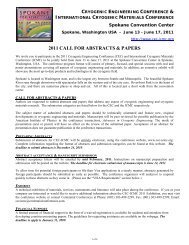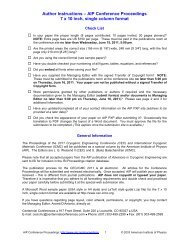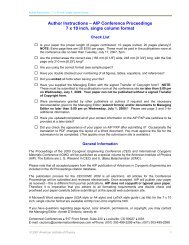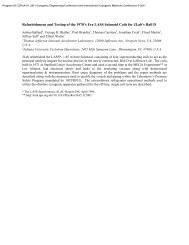CEC Abstracts in PDF format (as of 7/3/07) - CEC-ICMC 2013
CEC Abstracts in PDF format (as of 7/3/07) - CEC-ICMC 2013
CEC Abstracts in PDF format (as of 7/3/07) - CEC-ICMC 2013
Create successful ePaper yourself
Turn your PDF publications into a flip-book with our unique Google optimized e-Paper software.
<strong>CEC</strong> 20<strong>07</strong> - <strong>Abstracts</strong><br />
C1-N-09 Understand<strong>in</strong>g dynamic behavior <strong>of</strong> a large scale<br />
cryogenic plant<br />
R. Maekawa, K. Ooba, T. Mito, National Institute for<br />
Fusion Science; M. Nobutoki, Taiyo Nippon Sanso Co.<br />
Development <strong>of</strong> Cryogenic Process REal-time SimulaTor (C-PREST)<br />
h<strong>as</strong> been f<strong>in</strong>alized to provide a platform to study refrigeration process<br />
simulation for the entire cryogenic system for the Large Helical<br />
Device (LHD). To understand dynamic behavior <strong>of</strong> the LHD<br />
cryogenic plant, the simulations have been carried out dur<strong>in</strong>g the<br />
cooldown operation. Although LHD h<strong>as</strong> three different cool<strong>in</strong>g<br />
schemes, a pool boil<strong>in</strong>g, a forced-flow supercritical helium cool<strong>in</strong>g<br />
and a two-ph<strong>as</strong>e flow cool<strong>in</strong>g, C-PREST simulates comparable results<br />
<strong>of</strong> LHD cooldown process. To validate the versatility <strong>of</strong> C-PREST,<br />
the heat pulse(s) were applied to the 20000 liters liquid helium<br />
reservoir <strong>of</strong> a helium refrigerator/liquefier. This paper describes<br />
operations <strong>of</strong> large cryogenic plant and discusses dynamic behavior <strong>of</strong><br />
helium refrigerator/liquefier under various heat pulse <strong>in</strong>puts.<br />
Tuesday, <strong>07</strong>/17/<strong>07</strong> Oral<br />
3:00pm - 5:00pm<br />
C1-O Stirl<strong>in</strong>g and Pulse Tube Capabilities<br />
Overview (Aerospace)<br />
C1-O-01 Heritage Overview: 20 Years <strong>of</strong> Commercial<br />
Cryocooler Production for Space<br />
A.S. Gibson, J.S. Reed, EADS Astrium Limited.<br />
Space cryocooler production (formerly BAe and MMS) h<strong>as</strong> spanned<br />
more than 2 decades. Industrialisation h<strong>as</strong> taken the cryocooler from<br />
the laboratory to a proven space product. Over this period, Astrium<br />
have manufactured more than 50 Stirl<strong>in</strong>g coolers, 15 <strong>of</strong> which have<br />
flown. An historical review with lessons learned is presented.<br />
Follow<strong>in</strong>g transfer <strong>of</strong> the heritage design via Rutherford Appleton<br />
Laboratory (RAL), manufactur<strong>in</strong>g began at Astrium on the first 80K<br />
Stirl<strong>in</strong>g coolers <strong>in</strong> 1986, with production <strong>of</strong> 2 development models (1<br />
for ESA) and an EM unit. Follow<strong>in</strong>g successes <strong>of</strong> Oxford/RAL<br />
coolers on ISAMS, ATSR-1 and ATSR-2, Astrium built standard 80K<br />
units for IMG-ADEOS(1996) and HTSSE-II(1997). 23 coolers <strong>of</strong> this<br />
type were built <strong>in</strong> 4 batches. A higher heat lift version (1991) led to<br />
the standard 50-80K product. These cont<strong>in</strong>ue to fly <strong>in</strong> pairs on<br />
MOPITT(1999), MIPAS(2002), AATSR(2002), INTEGRAL(2002)<br />
and a military satellite (2004), with a s<strong>in</strong>gle unit on ODIN(2001).<br />
Another pair is to be launched <strong>in</strong> 20<strong>07</strong>.<br />
Industrialisation <strong>of</strong> a 2-stage RAL Stirl<strong>in</strong>g cooler design began <strong>in</strong><br />
1990 (ESA funded), to provide cool<strong>in</strong>g from 20-50K. An EM w<strong>as</strong><br />
produced, followed by 3 QM units. In 2000, an improved 10K design<br />
(collaboration with RAL) w<strong>as</strong> built for the US-Air Force Research<br />
Laboratory yielded a record temperature <strong>of</strong> 9.4K. Notably,<br />
development <strong>of</strong> this design h<strong>as</strong> recently been re-<strong>in</strong>itiated (ESA<br />
fund<strong>in</strong>g).<br />
Astrium would like to acknowledge fund<strong>in</strong>g from ESA for<br />
<strong>in</strong>dustrialisation <strong>of</strong> cryocoolers.<br />
C1-O-02 An Overview <strong>of</strong> the Performance and Maturity<br />
<strong>of</strong> Long Life Cryocoolers for Space Applications<br />
D.G. Curran, S.W. Yuan, The Aerospace Corporation.<br />
A 20<strong>07</strong> survey is made <strong>of</strong> long life cryocoolers <strong>in</strong>volv<strong>in</strong>g Stirl<strong>in</strong>g,<br />
Pulse Tube, reverse Brayton, and Hybrid variants for space<br />
applications. A number <strong>of</strong> unit configuration types <strong>in</strong>volv<strong>in</strong>g s<strong>in</strong>gle<br />
and multi-temperature stages is <strong>in</strong>cluded. The performance range<br />
varies from milliwatts <strong>of</strong> cool<strong>in</strong>g at 4K to 10`s <strong>of</strong> watts at 150K. The<br />
objectives for this survey are to provide a hardware summary <strong>of</strong><br />
available units from several U.S. manufacturers <strong>in</strong>clud<strong>in</strong>g the heritage<br />
and maturity level suitable for space use <strong>in</strong> payloads and <strong>in</strong>struments.<br />
Listed <strong>in</strong> the summary are life test and flight hours, environmental test<br />
levels, size, and electronics controller capabilities <strong>as</strong> well <strong>as</strong> load<br />
curves and specific power <strong>as</strong> a function <strong>of</strong> temperature.<br />
C1-O-03 Endurance Evaluation <strong>of</strong> Long-Life Space<br />
Cryocoolers at AFRL- An Update<br />
J. Sutliff, W. Scheirer, E. Pettyjohn, T. Roberts,<br />
AFRL/VSSS.<br />
The Air Force Research Lab (AFRL) <strong>in</strong> conjunction with various<br />
defense contractors h<strong>as</strong> developed several long-life cryocooler<br />
designs. These cooler <strong>in</strong>clude the NGST HEC, the Raytheon PSC, the<br />
Ball 6020, and the Ball 35-60K. They represent different technologies<br />
<strong>in</strong>clud<strong>in</strong>g pulse tube and Stirl<strong>in</strong>g cycle. The coolers operat<strong>in</strong>g times<br />
range from the NGST HEC which h<strong>as</strong> been runn<strong>in</strong>g 28,000 hours to<br />
the TRW 6020 which h<strong>as</strong> been operat<strong>in</strong>g for more that 69,000 hours.<br />
Endurance evaluation attempts to describe the long-life potential <strong>of</strong><br />
these mach<strong>in</strong>es with a complete demonstration <strong>of</strong> these mach<strong>in</strong>es<br />
be<strong>in</strong>g 5-10 years <strong>of</strong> constant operational life <strong>in</strong> an environment<br />
designed to simulate the conditions <strong>of</strong> space. The test<strong>in</strong>g hopes to<br />
show any wear out, fatigue, or electronic malfunction so that<br />
cryocoolers will cont<strong>in</strong>ue to improve their long-life potential.<br />
Endurance test<strong>in</strong>g also quantifies the performance degradation over<br />
time to help determ<strong>in</strong>e needs <strong>of</strong> future satellites. Data presented<br />
<strong>in</strong>dicates that certa<strong>in</strong> degradation patterns exist <strong>in</strong> these cryogenic<br />
refrigerators which will pose a challenge for their long term use <strong>in</strong><br />
multi-year missions.<br />
C1-O-04 Air Liquide Space Pulse Tube Cryocoolers<br />
T. Trollier, J. Tanchon, J. Buquet, A. Ravex, P.<br />
Crespi, Air Liquide Advanced Technology Division,<br />
AL/DTA, S<strong>as</strong>senage, France.<br />
Thanks to important development efforts completed and partial ESA<br />
fund<strong>in</strong>g, AL/DTA is now <strong>in</strong> position to propose two Pulse Tube<br />
cooler systems <strong>in</strong> the 40-80K temperature range for com<strong>in</strong>g Earth<br />
Observation missions such <strong>as</strong> MTG, Sent<strong>in</strong>el 3, etc… The two pulse<br />
tube coolers thermo-mechanical units are yet qualified aga<strong>in</strong>st<br />
environmental constra<strong>in</strong>ts.<br />
In addition to these two Pulse Tube cooler systems, a 20-50K multistage<br />
low temperature Pulse Tube cooler is currently under<br />
development for future Scientist Missions such <strong>as</strong> Xeus, Darw<strong>in</strong>, etc..<br />
The paper presents the current status <strong>of</strong> each <strong>of</strong> the three thermomechanical<br />
units and <strong>as</strong>sociated cooler drive electronics.<br />
C1-O-05 High Performance Pulse Tube Cryocoolers<br />
J.R. Olson, P. Champagne, E. Roth, B. Evtimov, T.C.<br />
N<strong>as</strong>t, Lockheed Mart<strong>in</strong> ATC.<br />
Lockheed Mart<strong>in</strong>’s Advanced Technology Center (LM-ATC) h<strong>as</strong><br />
been develop<strong>in</strong>g pulse tube cryocoolers for more than ten years.<br />
Recent <strong>in</strong>novations <strong>in</strong>clude successful test<strong>in</strong>g <strong>of</strong> four-stage coldheads,<br />
no-load temperatures below 4 K, and the recent development <strong>of</strong> a<br />
high-efficiency compressor.<br />
This paper discusses the predicted performance <strong>of</strong> s<strong>in</strong>gle and multiple<br />
stage pulse tube coldheads driven by our new 5 kg “M5Midi”<br />
compressor, which is capable <strong>of</strong> 90% efficiency with 200W <strong>in</strong>put<br />
power, and a maximum <strong>in</strong>put power <strong>of</strong> 1000W. This compressor<br />
reta<strong>in</strong>s the simplicity <strong>of</strong> earlier LM-ATC compressors: it h<strong>as</strong> a<br />
mov<strong>in</strong>g magnet and an external electrical coil, m<strong>in</strong>imiz<strong>in</strong>g organics <strong>in</strong><br />
the work<strong>in</strong>g g<strong>as</strong> and requir<strong>in</strong>g no electrical penetrations through the<br />
pressure wall. Motor losses were m<strong>in</strong>imized dur<strong>in</strong>g design, result<strong>in</strong>g<br />
<strong>in</strong> a simple, e<strong>as</strong>ily-manufactured compressor with state-<strong>of</strong>-the-art<br />
motor efficiency.<br />
The predicted cryocooler performance is presented <strong>as</strong> simple<br />
formulae, allow<strong>in</strong>g an eng<strong>in</strong>eer to <strong>in</strong>clude the impact <strong>of</strong> a highlyoptimized<br />
cryocooler <strong>in</strong>to a full system analysis. Performance is<br />
given <strong>as</strong> a function <strong>of</strong> the heat rejection temperature and the cold tip<br />
temperature and cool<strong>in</strong>g load. A discussion <strong>of</strong> the optimum number<br />
<strong>of</strong> coldhead stages will be given. We will also discuss a novel<br />
configuration where the compressor operates with no heat rejection,<br />
allow<strong>in</strong>g very flimsy attachment to the satellite so <strong>as</strong> to m<strong>in</strong>imize<br />
exported vibration.<br />
Page 16 <strong>of</strong> 53






